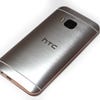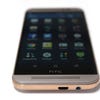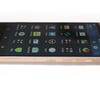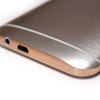HTC One M9 review
Third time's a charm?
HTC's last two flagship Android handsets have done much to make up the ground lost to Samsung's trailblazing Galaxy S range. However, last year's HTC One M8, impressive as it was, felt like only a minor jump over what preceded it. Evolutionary rather than revolutionary, it took a leaf out of Apple's book by subtly enhancing the M7's design, mimicking the two-year design cycle popularised by the Cupertino company. This year's model arguably takes even more modest steps forward, offering a device that, to the layperson, is mostly identical to its predecessor in its aesthetic. There are improvements under the bonnet and this is without a doubt one of the best-made and most luxurious Android handsets on the market - but it's hard to shake the impression that HTC is stumbling back into the rut it tried so valiantly to escape in 2013.
Someone at HTC is clearly proud of the One's design, as its stylish aluminium-framed look has been retained for a third time - albeit with minor alterations. The back of the device is hewn from a single slab of scratch-resistant metal and boasts a premium feel that is unmatched in the Android arena - and, it must be said, even puts Apple's typically lush handsets to shame. New colour options are on the table this year, with a two-tone gold and silver unit making the phone very nearly resemble an item of jewellery.
It's a look we're not entirely sure works; the rear of the phone is a close match to the M8, but the gold edging comes across as a little tacky. We're also not convinced the power button's new home - on the right-hand edge, slap-bang in the middle - is the most ergonomic choice. It's just below two volume buttons of a similar size and shape, and is consequently difficult to find in a hurry. All in all though, this is a handsome device with a premium feel, and on some level it's easy to see why HTC doesn't want to consign this particular template to the scrapheap just yet. Few other Android phones come close, at least in terms of aesthetic charm.
While the HTC One M8's screen grew in size when compared to the M7, the M9 remains totally static. The 5-inch, 1080p Super LCD3 panel has the same pixel density of 441ppi, and - as we pointed out last year - can't hold a candle to the best AMOLED screens out there when it comes to contrast and vibrancy. Granted, AMOLED panels tend to produce exaggerated colours, but it's a trade-off worth making, especially given how washed out the M9's display is in comparison. In the face of 2.5K screens used in other flagship phones this year, the choice to avoid bumping the M9's screen resolution is a surprise. In some respects this is a plus point; we're fast approaching a point of diminishing visual turns, and a resolution bump only increases the burden on a processor. The gains would have been slight, unless you plan on pressing your nose up to the glass for a closer inspection.
There are some familiar elements to the M9 which you won't mind seeing - or, in this case, hearing - again. The Boomsound speakers are just as powerful as they were last year, and really bring the phone to life as a multimedia player. Music sounds great, and movies downloaded or streamed via Netflix or Amazon Prime Video are enriched by its superior volume compared to most phone speakers. Refreshingly, the power doesn't come at the expense of overall clarity, either. Google and Motorola have attempted a similar trick with the Nexus 6, but at maximum volume the M9 is a clear front-runner in this area. The sound tech has a positive impact on call quality too, as the uppermost Boomsound speaker above the screen is used during calls and provides excellent results.
Internally, the HTC One M9 sports a top-of-the-line Snapdragon 810 chipset that contains an octa-core setup. This is essentially two quad-core chips in one, a 1.5 GHz Cortex-A53 and a 2 GHz Cortex-A57, that are toggled between based on the intensity of any task. There's an Adreno 430 graphics processor thrown into the mix also, and 3GB of RAM rounding off the picture. The numbers speak for themselves in our benchmarks, and expectedly its 3D performance in games stands up comfortably against this year's other flagship releases.
The M9 is blessed with a fearsome arsenal of tech, but it has attracted some negative attention for generating excessive amounts of heat. It's true that when engaged in a particularly taxing activity the phone's casing becomes noticeably warm, but no more so than many of its cutting-edge rivals, and we suspect the reason it's more immediately obvious here is because the aluminium casing is channelling the heat more effectively. During our review we felt we pushed HTC's device to the limit, and it never got uncomfortably hot - something which was claimed in many early hands-on previews by other sites.
| HTC One M9 | Google Nexus 6 | Galaxy S5 | Galaxy Note 4 | iPhone 6 | iPhone 6 Plus | |
|---|---|---|---|---|---|---|
| Geekbench Single-Core | 1087 | 1053 | 372 | 1266 | 1605 | 1606 |
| Geekbench Multi-Core | 3496 | 3081 | 2949 | 4333 | 2901 | 2903 |
| 3DMark Graphics | 34795 | 24668 | 17464 | 20222 | 22824 | 24067 |
| 3DMark Physics | 10242 | 17259 | 15541 | 17430 | 9385 | 9320 |
| 3DMark IceStorm Unlimited | 22701 | 23205 | 18524 | 19544 | 17304 | 17782 |
| GFXBench T-Rex | 49.0 | 37.0 | 27.4 | 41.7 | 42.8 | 44.6 |
With this much power to hand, HTC has clearly had to put measures in place to shackle this beast. Running at full pelt, the M9's internals would usually drain its 2840mAh in no time at all. To combat this, the phone attempts to strike a balance by giving you just enough power when you need it, but eases off the accelerator once things become too demanding. It's a problem every mobile maker faces, as battery technology simply isn't keeping pace with CPU evolution, and all that can be done is to cram bigger power cells into phones. While the M9 certainly isn't the most ravenous handset we've encountered, its stamina is hardly awe-inspiring. You'll almost certainly have to charge it every day if you intend to make the most of the Snapdragon 810 chipset's potential.
Thankfully the M9 supports quick charging, meaning those with the right equipment don't need to wait too long between bouts of use. Like Google's Nexus 6, you can fill up the battery entirely in around an hour with this approach, and 15 minutes of charge provides an impressive six hours of use. Sadly, HTC doesn't ship the phone with a compatible high-speed charger in the box. You'll have to pick one up at an additional cost; a bit of a slap in the face, given how expensive the device is in the first place.
With Android 5.0 Lollipop on board, the HTC One M9 is blessed with all of the latest improvements Google has introduced to its mobile OS. As ever, HTC's own Sense UI sits comfortably on top and is as subtle as it has ever been. HTC's own social and news aggregation tool Blinkfeed still clings on for dear life, but with each passing year it becomes less and less essential. Google Now has effectively transplanted it as the go-to app for this kind of thing, although it should be noted that at present, Google's offering doesn't integrate with social networks. Even so, it's infinitely more useful on a daily basis, and while you can still access it on the M9 with a long press of the Home button, we missed it being on the far-left home screen, always ready to offer up information on traffic, shipped parcels or football scores.

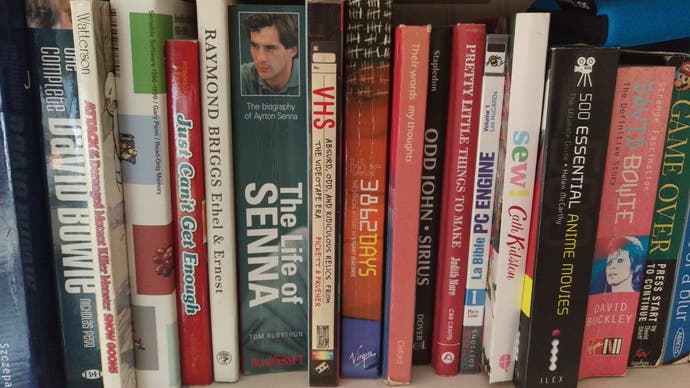
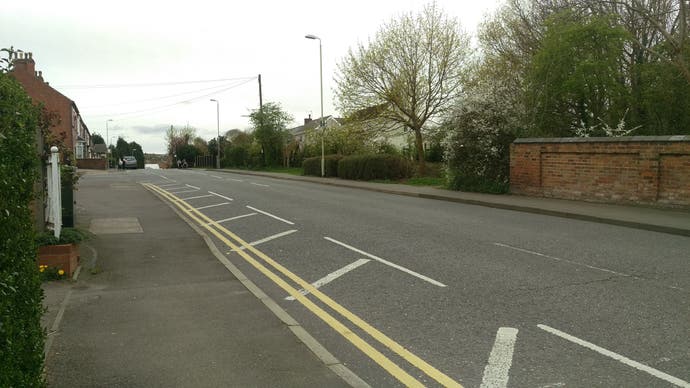

Elsewhere, HTC's exclusive software is more useful. Its photo-editing tool Zoe is extracted from the camera application - a good move if you want to totally ignore it, as many will - but the dedicated theme generator is fantastic. Not only does it offer access to many unique themes, but it also allows you to create your own using nothing but a photo. Pick the snap and the software will create a theme that matches it in terms of colour, and the results are, by and large, aesthetically pleasing.
One of the biggest changes you'll find in the M9 is at the back of the device. The much-hyped UltraPixel camera sensor, which only offered 4 megapixels but used larger pixels to allow more light into the lens, is gone. In its stead, we have a more traditional 20.7 megapixel snapper, while the rather gimmicky dual camera configuration of the M8 has wisely been abandoned. HTC has essentially blinked in the face of its rivals; the UltraPixel concept was a brave one that made the not-unreasonable assumption that better-lit photos are superior to those with massive amounts of detail. But rather than evolve it, the company chooses to cast it aside and join the tiresome megapixel arms race.
The new camera takes photos that hold up well when zoomed, but it suffers from the usual problems: low-light shooting is tricky, and the phone has a tendency to overexpose images when there's a marked contrast in lighting. Last year's UltraPixel sensor hasn't been totally binned, meanwhile. It's been transplanted to the front of the phone, where it's used to take some of the more impressive selfies yet seen on a smartphone, if you're that way inclined. As for video recording, the M9's camera tops at 2160p at 30 fps, with 1080p recording offering a smoother 60fps, while the 720p mode opens the gates to 120 fps.
Like the Nexus 6, the HTC One M9 comes with 32GB of storage at a time when many rival devices have half that total. HTC's handset has the added advantage of expandability too; you can slot in a microSD card of up to 128GB in capacity. This will come as excellent news to those who want to use their phone as a multimedia powerhouse, although it should be noted that inserting a card containing a lot of content could impact the overall performance of the phone.
HTC One M9: the Digital Foundry verdict
HTC's process of iterating its phones isn't a negative thing in itself; sometimes its worth developing a design, especially when it's one that is as appealing as this. The key issue with the M9 is that it doesn't deliver the gains you'd expect when asked to shell out for a new monthly contract or up-front fee. While the internal tech has improved, the battery isn't up to the task of letting its Snapdragon 810 fully stretch its legs, and as a result the HTC One M9 is something of a caged animal, never truly allowed to achieve its full potential.
Strictly in terms of its build quality and design, HTC adds little to the menu this time. The screen is identical to the M8's of last year, and the 20.7 megapixel camera - while capable of detailed shots - is a disappointing side-step from what HTC promised with its UltraPixel technology. Outside of these aspects, there's no unique twist to the M9 to celebrate; no fingerprint scanner, no ambient display, while the dual-camera arrangement that garnered so much attention on the M8 is gone.
As such, the HTC One M9 represents something of a crossroads for its manufacturer. It's not a bad effort by any stretch of the imagination, as the design is easily among the best in the Android sector, while the power is considerable when allowed to show its potential. However, without a massive step forward, it risks being lost amid a sea of more capable and alluring competitors this year. The M9 looks and sounds the part, and should keep tills ringing for the Taiwanese firm throughout 2015, but its next move is a pivotal one - and prospective buyers would do well to investigate other options before committing their cash, such as the massive Nexus 6 and the Samsung Galaxy S6.



